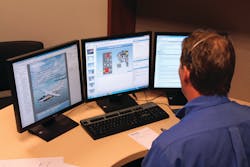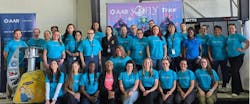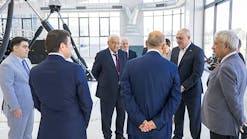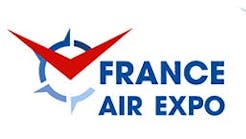A few decades ago most maintenance training was instructor lead requiring students to travel to a training center or classroom, or instructors to travel to a maintenance organization to deliver their training. Most of us have attended this style training in our careers. As computer systems developed so did eLearning such as computer-based training (CBT), generally delivering self-paced learning via CD-ROM on a desktop computer.
While eLearning is a self-paced course with no live instructor or classmate interaction, today the virtual classroom can utilize a live instructor and provide real-time classroom interaction. Directors of training have the ability to enroll their employees in dynamic courses that emulate 100 percent of what goes on in the classroom, from presentation to exam and course critique. Originally developed to teach specialty and enrichment courses, LiveLearning® was trade marked by FlightSafety International several years ago to differentiate itself from traditional eLearning platforms.
LiveLearning allows clients to train at their location prior to or after their normally scheduled aircraft specific training, saving time spent away from home. The first of these courses taught was Cold Weather Operations which was developed to meet all FAA requirements for an instructor-led course, while maintaining client/instructor interaction. This virtual classroom course was a great success and more training opportunities were requested. Based on client feedback, the online curriculum was expanded and now offers multiple LiveLearning courses for pilots and has recently expanded this option for maintenance training.
Steven Ralston, assistant director of programs for FlightSafety International Cessna Maintenance Learning Center, explains, “We found that maintenance operations feel it is important to send their technicians to initial training on a specific aircraft, but some operations find it difficult to send their technicians back for additional training. This is often due to the loss of the maintenance technician for a week or more while they are away for training. LiveLearning courses are the solution for this.” Supported by his center manager, John Brasfield, he directed his development team to start work on bringing specific maintenance courses out of the classroom and into the LiveLearning arena, starting with the Cessna 208EX Caravan Differences Course.
The LiveLearning process is very simple for the client. The scheduling process is similar to other courses and clients can view courses on the FlightSafety web site, or call a customer support representative to discuss class availability. Once scheduled, the client will receive an email a few days prior to the class date. This email contains instructions for checking client connectivity, class start time, and minimum computer requirements (clients need to have the most current version of Flash Player installed). It will also contain a link to the course materials that the client can use electronically or print out prior to class and a link to the LiveLearning class itself. This link is a direct connection to the virtual classroom used to deliver the course.
Once signed into the course, the technical host welcomes each client, provides a brief client and instructor introduction and reviews the tools available for use during the class. These tools allow the client to interact with the instructor and other clients in multiple ways. The most important way instructors and clients interact is via voice communications, which are established when the client logs into the course. Each client’s name is displayed on the screen in the participant’s panel, giving all clients the ability to see the names of all class participants. The LiveLearning interface has a number of tools that facilitate communication with the instructor such as a raised hand next to their name to indicate they have a question, a green check mark to let the instructor know that they understand the information, and a red X to indicate the need for further clarification. There’s even a coffee cup icon that clients and instructors use to indicate break time! LiveLearning also contains text-based chat, allowing the client to message all participants, a specific client, or just the instructor. This chat tool allows the client to ask a question that only the instructor can see which helps keep more reserved clients involved in the course.
The presentation used in the course is the same presentation used at the learning center; however, in the virtual environment clients can annotate or illustrate on the slides that the instructor is using. This is especially helpful when a client needs clarification of something on the slide - both client and instructor will be able to see the pointer and hear the question. Instructors can also call up and use several other training tools such as Dynamic Slide Presentations (DSPs). These animated tools are tailored to specific aircraft systems and can be shared in real time, facilitating class discussion as needed. While displaying the DSPs, the instructor can manipulate valves, fuel flow, pumps, electrical signals, etc., thus bringing the same level of animation that in-house clients get.
Another great tool used for complete system integration training is the Desktop Simulator (DTS). DTS is a part of FlightSafety’s MATRIX training solution for desktop simulation. By utilizing DTS, the instructor can display animated systems as well as the cockpit, which allows the client to see how controls affect aircraft systems in real time. One example of DTS usage would be an engine start procedure. DTS will allow the manipulation of the appropriate controls and switches, while cockpit instruments give the correct indications and an animated system schematic runs simultaneously. Malfunctions can also be included for troubleshooting courses and system comparisons made between models in the differences courses.
The instructor uses these tools to facilitate open class conversation and ensure the delivery of course objectives to the client. Any time an instructor is using DSP or DTS, clients can use their annotation tools. Other clients can see those annotations, hear the conversation between the instructor and the client, and join in on the conversation creating a truly dynamic classroom-training experience.
Since teaching the first of these maintenance courses, Principles of Troubleshooting in January of 2013, other aircraft specific maintenance courses for Cessna products have been added. They include a one-day 208EX Differences course, a four-day Caravan Troubleshooter course, a 10-day non-regulatory Caravan Initial course, a Sovereign+ Differences course, a Citation X Differences course, and a M2 Differences course. Each of these courses is taught three hours per day. More classes will be added in the future based on customer feedback and requests.
The true value of the virtual classroom is the ability to reach clients who would be unable to come to training due to distance, or other factors but still want a dynamic classroom experience. This value has been realized over the past year, as clients from Australia to Nigeria have taken classes, keeping the maintenance technician on site and available to work for the part of the day they are not in class.
Instructor lead training and CBT will always be available. But, if you’re looking for a way to supplement your current maintenance training program with convenient and interactive courses that would keep your employees close to home, consider the benefits a virtual classroom has to offer your maintenance department.
For more information visit www.FlightSafety.com/LiveLearning or call (800) 488-3747 for Cessna specific courses.






